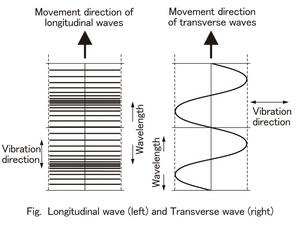Nagoya City Science Museum
TOP > Exhibition Guide > Keyword Search > Starting with "I" > interference > Longitudinal and Transverse Wave Motion
Longitudinal and Transverse Wave Motion



Purpose of Exhibition
There are two types of waves, transverse and longitudinal waves.
By observing the device attached to the Exhibition room ceiling that generates transverse and longitudinal 10-meters-long waves, we can understand the difference in properties between the two types of waves.
Additional Knowledge
Waves can be divided into two types according to how they transmit.
This is what is called transverse and longitudinal waves. The difference between transverse and longitudinal waves is the direction in which the waves shake.
If the wave shakes perpendicular to the movement direction, it's a transverse wave, if it shakes in the movement direction, then it's a longitudinal wave.
[Transverse Wave]
It is easy to imagine a transverse wave.The waves transmitted from a tightened rope when shaken are transverse waves.
Waves are generated by the vibration of matter.
In the case of the rope, the vibration of the rope itself.
When the vibration direction is perpendicular to the wave movement direction, it is called a transverse wave.
In the exhibit, parallel horizontal rods like a centipede legs are shaken up and down, transmitting waves. As the wave's movement direction and the rod's shaking direction are perpendicular, it demonstrates that those are transverse waves.
[Longitudinal Wave]
Conversely, it's quite difficult to imagine a longitudinal wave.
The exhibit demonstrates longitudinal waves using a 10m spring.
By looking closely at the exhibit, you can see that when the spring is pressed, transmission occurs at the short part of intervals. You can see the spring's stripe pattern moving. Those stripes movements are waves.
Because the image is different from a typical wave, it is difficult to call them waves as such.
Longitudinal waves are also known as compression waves. That name better represents what actually happens. As one can see in the movement of the exhibit, the 'loose' part and 'tight' part are transmitted as part of the nature of the longitudinal waves. In the case of longitudinal waves the wave direction is vertical, which is why the name longitudinal was adopted.
[Sound is a longitudinal wave]
Sound is a vibration of the air.
Also, the vibration is not a transverse wave, but a longitudinal wave. When a loud sound is made, because the things around you are shaking, it is easy to understand that the sound is the vibration of air. However, to understand that sound is a longitudinal wave is not as easy.
The density of the pressed molecule is transmitted to the next, and then it's an air wave, as well as a sound wave.
In this way, compression-transmitting waves are transverse waves.
[Earthquakes are longitudinal and transverse waves]
An earthquake is the transmission of a tremor occurring at an epicenter.
Earthquakes become waves, which spread, shaking the ground.
Earthquakes create both longitudinal and transverse waves. Also, one characteristic is that a longitudinal wave's transmission is faster than transverse waves. If the longitudinal wave of an earthquake is called the P wave, it is the initial tremor before the big tremor.
If the transverse wave is called the S wave, it is the big tremor after the initial tremor.
Both transverse and longitudinal waves occur in solids such as metals and rocks.
[Light and Waves]
Light also has waves characteristics. Not longitudinal waves, but transverse waves. As evidence of transverse waves, a phenomenon called light polarization occurs.
The length of a wave may reveal the characteristics of that wave. In the case of the ocean waves, the wave length is the distance between wave crest and wave crest.
In the case of light, the difference of wave length is the difference of color.
The long waves in light waves are red, and the short waves are blue.
The human eye cannot see longer wave lengths than red such as infrared rays and electromagnetic waves. Waves with length shorter than blue are ultraviolet rays, x-rays and gamma rays.
Article by Yoshitaka Yamada, curator
